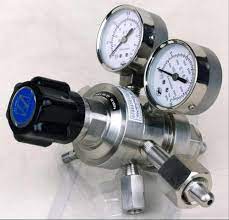2-stage gas regulators stand as critical components that play a pivotal role in ensuring consistent gas pressure, safety, and optimal performance. These advanced devices are designed to regulate the pressure of gas flowing from a high-pressure source to a lower pressure required by various applications. With their unique design and functionality, 2-stage gas regulators offer distinct benefits in terms of precision, stability, and safety. In this article, we delve into the world of 2-stage gas regulators, understanding their types, functions, benefits, applications, technologies, challenges, and the transformative impact they have on gas distribution systems.
Understanding 2-Stage Gas Regulators:
A 2-stage gas regulator is a specialized device used to reduce the pressure of high-pressure gas to a lower, stable pressure suitable for specific applications. Unlike single-stage regulators, which provide a single pressure reduction, 2-stage regulators offer an additional level of pressure reduction for enhanced precision and performance.
Key Functions and Benefits:
- Pressure Reduction: The primary function of a 2-stage gas regulator is to reduce the high-pressure gas from the supply source to a lower, more manageable pressure for downstream applications.
- Stable Output Pressure: 2-stage regulators provide a more consistent and stable output pressure, even when the supply pressure varies.
- Precise Control: These regulators offer finer pressure control, making them suitable for applications that require accurate pressure adjustments.
- Enhanced Safety: By providing a two-step pressure reduction, 2-stage regulators offer an added layer of safety by minimizing the potential for sudden pressure spikes.
- Improved Performance: In applications that demand steady and precise gas pressure, 2-stage regulators ensure consistent performance.
Types of 2-Stage Gas Regulators:
- Two-Stage Single-Outlet Regulators: These regulators have a single outlet for gas supply, making them suitable for applications that require a constant gas pressure.
- Two-Stage Dual-Outlet Regulators: Dual-outlet regulators have two separate outlets, each with its own adjustable pressure settings. These are often used for applications that require different pressure levels simultaneously.
Technologies and Working Principles:
2-stage gas regulators work based on the principles of pressure reduction and controlled flow. They consist of two internal pressure reduction stages. In the first stage, the high-pressure gas is reduced to an intermediate pressure, and in the second stage, the gas is further reduced to the desired output pressure.
Applications of 2-Stage Gas Regulators:
- Industrial Processes: 2-stage regulators are used in various industrial applications, including welding, metal fabrication, and manufacturing, where consistent gas pressure is crucial for quality and efficiency.
- Laboratory Settings: In research and analytical laboratories, 2-stage regulators ensure stable gas pressure for sensitive equipment and experiments.
- Medical Applications: These regulators are used in medical settings to control gas pressure for medical gases used in procedures and patient care.
- Gas Chromatography: 2-stage regulators are vital in gas chromatography, where precise gas pressure is essential for accurate analysis.
Challenges and Considerations:
- Pressure Drop: While 2-stage regulators offer enhanced stability, there might be a slight pressure drop across the two stages.
- Calibration: Proper calibration of 2-stage regulators is essential to ensure that the output pressure matches the desired setting.
Integration with Gas Systems:
Modern 2-stage gas regulators can be integrated into gas control and distribution systems, allowing for remote monitoring, data collection, and automation of pressure adjustments.
Conclusion:
2-stage gas regulators are integral to maintaining precision, stability, and safety in various gas-related applications. From industrial processes to laboratory settings, their ability to provide consistent and controlled gas pressure enhances performance, quality, and safety. By offering a two-step pressure reduction process, 2-stage regulators ensure that downstream equipment and applications receive the appropriate pressure for optimal operation. As industries evolve and demand more precise pressure control, these regulators stand as essential components that contribute to efficient, reliable, and safe gas distribution and utilization.
